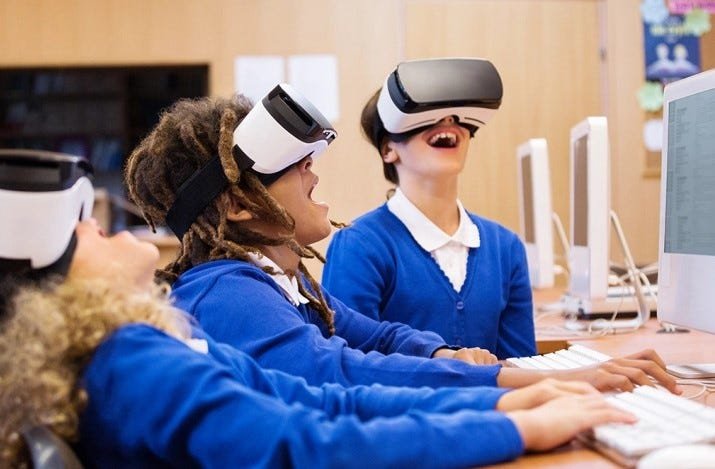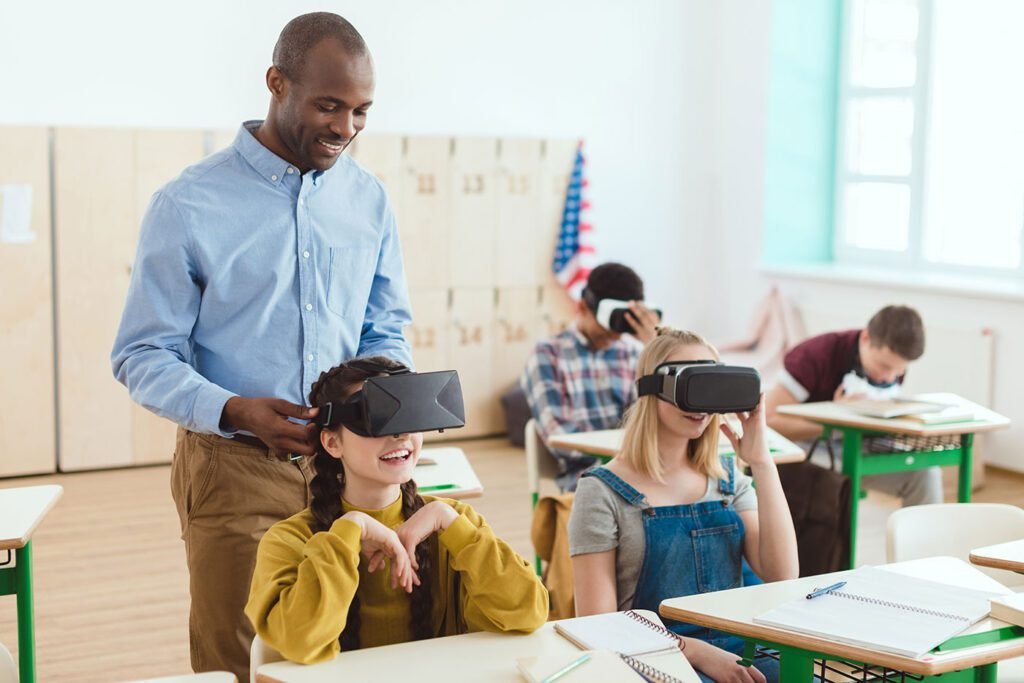In a groundbreaking initiative, public schools across the UAE are embracing the future of education through virtual reality (VR) classrooms. As part of a pilot program, several schools have begun incorporating VR into their teaching methods, offering a completely immersive and innovative learning experience. This initiative aims to equip students with the necessary skills to thrive in an increasingly digital world while improving their overall educational experience.
The Power of Virtual Reality in Education
Virtual reality has long been associated with entertainment and gaming, but its potential to revolutionize education has become increasingly clear. By immersing students in digital environments, VR allows them to experience and interact with content in ways that traditional classrooms cannot offer. Imagine exploring the depths of the ocean, walking through ancient civilizations, or conducting virtual science experiments—experiences that would otherwise be impossible in a typical classroom setting.
The integration of VR technology into public schools is expected to offer more dynamic and engaging lessons that go beyond textbooks and lectures. Teachers can create virtual simulations that provide students with first-hand experiences of topics ranging from history and geography to biology and physics. This shift promises to make learning more engaging, practical, and enjoyable for students.

The Pilot Program: A Glimpse Into the Future

The pilot program, which began earlier this year, has been implemented in selected public schools in major cities like Abu Dhabi and Dubai. Schools participating in the initiative have received VR headsets, software, and training, with teachers learning how to effectively use the technology in their lessons. The government has partnered with leading tech companies to ensure that the technology used is up-to-date and capable of supporting the curriculum.
The goal of the pilot program is to assess how well VR can be integrated into various subjects and whether it improves students’ understanding of complex concepts. Educators are excited about the potential of VR to make abstract concepts more tangible. For instance, students studying history can now “walk” through ancient Rome or explore the pyramids of Egypt in 3D, making lessons more interactive and memorable.
How VR Can Transform the Learning Experience
One of the most exciting aspects of VR in classrooms is its ability to break down the barriers of traditional learning. In the past, students often had to rely on books, diagrams, and videos to understand complicated topics. While these methods can be effective, they don’t provide the same level of engagement as a hands-on experience. With VR, students can actually experience the concepts they are learning about, which makes the process more interactive and effective.
For example, students learning about the human circulatory system can virtually explore the heart and bloodstream, gaining a deeper understanding of how the body works. Science students can take part in simulated laboratory experiments that might be too dangerous or impractical to perform in real life. Geography lessons can come alive as students explore different parts of the world, from the frozen tundra of the Arctic to the hot deserts of the Middle East.
By making these lessons more immersive, VR helps students retain information better and gain a deeper understanding of the world around them. It fosters critical thinking, problem-solving, and creativity as students are encouraged to think outside the box and engage with material in a way that’s both fun and educational.
Benefits Beyond the Classroom
While VR’s potential in the classroom is impressive, its benefits extend beyond the school environment. As students become more familiar with virtual reality technology, they will gain valuable digital skills that will be beneficial in their future careers. In a world where technology is increasingly shaping industries and job markets, familiarity with VR can give students a competitive edge in fields such as engineering, medicine, design, and even gaming.
Moreover, the immersive experience of VR can help students with disabilities or special learning needs by providing them with tailored lessons that suit their individual learning styles. For example, VR simulations can offer visual and auditory cues that support students with learning disabilities, making it easier for them to grasp complex concepts.
Teachers’ Perspectives on the VR Shift

Teachers have been quick to embrace the changes brought by VR, with many expressing excitement about the potential it has to enhance their teaching methods. For many educators, VR offers a fresh approach to subjects that can often feel abstract or difficult to understand. Teachers believe that VR will not only capture students’ attention but also encourage active participation in lessons.
However, it’s important to note that VR in education also comes with its challenges. Educators will need to adapt their teaching strategies to incorporate the new technology effectively. This might require additional training and preparation, as well as a shift in how lessons are structured. Teachers will also need to ensure that VR experiences complement the curriculum, rather than replace traditional teaching methods altogether.
Overcoming Challenges: The Road Ahead
As promising as this initiative is, the introduction of VR in classrooms is not without its challenges. One of the biggest concerns is the cost of the technology, including the headsets, software, and infrastructure needed to support it. While the UAE government has committed to providing these resources to participating schools, there is still the question of how to scale the initiative to all public schools across the country.
Another challenge is ensuring that students and teachers have access to the necessary training to make the most of the technology. Teachers will need time and support to understand how to incorporate VR effectively into their lessons, and students will need guidance on how to use the technology safely and responsibly.
Despite these challenges, the pilot program has already shown promising results. Early feedback from students and teachers has been overwhelmingly positive, with many praising the interactive nature of VR lessons and the increased engagement they bring to the classroom.
The Future of Virtual Reality in Education
Looking ahead, the UAE government is committed to expanding the VR initiative to more schools, with the goal of making it a permanent part of the educational landscape. As technology continues to evolve, VR will likely play an even greater role in shaping the future of education. With its ability to bring lessons to life and foster a deeper understanding of complex concepts, virtual reality could become an integral tool in classrooms worldwide.
Ultimately, the success of this pilot program could set the stage for similar initiatives in other countries, revolutionizing education and making learning more immersive, dynamic, and accessible than ever before. The future of education is here, and it’s virtual.
Also read: Ras Al Khaimah’s Vision for Climate-Resilient Urban Farming













